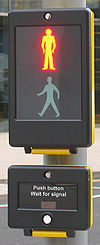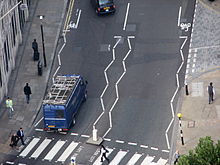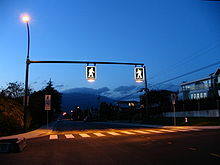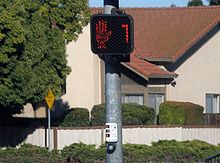- Pedestrian crossing
-
"Crosswalk" redirects here. For other uses, see Crosswalk (disambiguation).
 An adult and child prepare to use a crosswalk in Haifa, Israel.
An adult and child prepare to use a crosswalk in Haifa, Israel.
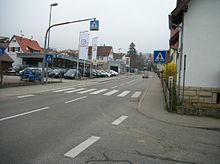 A crossing in Plattenhardt, Germany.
A crossing in Plattenhardt, Germany.
 Zebra crossing in Edinburgh, Scotland
Zebra crossing in Edinburgh, Scotland
A pedestrian crossing or crosswalk is a designated point on a road at which some means are employed to assist pedestrians wishing to cross. They are designed to keep pedestrians together where they can be seen by motorists, and where they can cross most safely across the flow of vehicular traffic. Pedestrian crossings are often found at intersections, but may also be at other points on busy roads that would otherwise be too unsafe to cross without assistance due to vehicle numbers, speed or road widths. They are also commonly installed where large numbers of pedestrians are attempting to cross (such as in shopping areas) or where vulnerable road users (such as school children) regularly cross.
Signalised pedestrian crossings clearly separate when each type of traffic (pedestrians or road vehicles) can use the crossing. Unsignalized crossings generally assist pedestrians, and usually prioritise pedestrians, depending on the locality. Pedestrian crossings, especially when combined with other features like pedestrian priority or raised surfaces, can be used as a traffic calming technique.
Contents
Characteristics
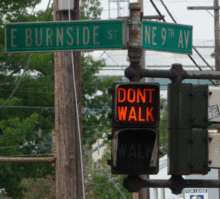 Pedestrian crossing signal in Portland, Oregon. Newer signals use symbols instead of word legends
Pedestrian crossing signal in Portland, Oregon. Newer signals use symbols instead of word legends
Crossings are of various types.
- The simplest crossings may just consist of some markings on the road surface. These are often called Zebra crossings, referring to the alternate white and black stripes painted on the road surface. Depending on local laws, pedestrians crossing the road may or may not have priority over road traffic when using the crossing. If the pedestrian has priority, then they have an incentive to use the crossing instead of crossing the road at other places. In some countries, pedestrians may not have priority, but may be committing an offence if they cross the road elsewhere (see Jaywalking).
- Some crossings have special signals consisting of electric lamps or light-emitting diode (LED) panels. The signals allow pedestrians and road traffic to use the crossing alternately. On some traffic signals, pressing a button is required to trigger the signal. These signals may be integrated into a regular traffic light arrangement or may be on their own if the crossing is not at an intersection. Audible or tactile signals may also be included to assist people who have poor sight. In many cities, some or most signals are equipped with countdown timers to give notice to both drivers and pedestrians the time remaining on the crossing signal.
- Sites with extremely high traffic, or roads where pedestrians are not allowed (freeways or motorways) may instead be crossed via pedestrian bridges or tunnels. A variation on the bridge concept, often called a skyway or skywalk, is sometimes implemented in regions that experience inclement weather.
Special markings are often made on the road surface, both to direct pedestrians and to prevent motorists from stopping vehicles in the way of foot traffic. There are many varieties of signal and marking layouts around the world and even within single countries. In the United States, there are many inconsistencies, although the variations are usually minor. There are several distinct types in the United Kingdom, each with their own name.
Pedestrian refuges or small islands in the middle of a street may be added when a street is very wide, as these crossings can be too long for some individuals to cross in one cycle. In places where there is very high pedestrian traffic, pedestrian scrambles (also known as Barnes Dances) may be used, which stop vehicular traffic in all directions at the same time. Another relatively widespread variation is the Curb (or kerb) extension (also known as a bulb-out) which narrows the width of the street and is used in combination with crosswalk markings.
Reports suggest that many walk buttons in some areas such as New York City are actually placebo buttons designed to give pedestrians an illusion of control while the crossing signal continues its operation as programmed.[1] This can also be witnessed at Anniesland Cross, a large road junction in Glasgow, Scotland. While each pedestrian crossing has a push button, all roads and pedestrian crossing run on a cycle and the pedestrian crossing will change only at the correct point of the cycle, whether the buttons are pushed or not.
History
The first pedestrian crossing signal was erected in Bridge Street, Westminster, London in December 1868. It was the idea of John Peak Knight, a railway engineer, who thought that it would provide a means to safely allow pedestrians to cross this busy thoroughfare. The signal consisted of a semaphore arm (Manufactured by Saxby and Farmer, who were railway signaling makers), which was raised and lowered manually by a police constable who would rotate a handle on the side of the pole. The semaphore arms were augmented by gas illuminated lights at the top (green and red) to increase visibility of the signal at night. However, in January 1869, the gas used to illuminate the lights at the top leaked and caused an explosion, injuring the police operator. No further work was done on signalled pedestrian crossings until fifty years later.[2]
By region
In the Commonwealth
In the United Kingdom and parts of the Commonwealth, animal names are often used to distinguish several types of such crossings:
- Zebra crossing: wide longitudinal stripes on road, often with belisha beacons; pedestrians may cross at any time; drivers must give way to pedestrians who demonstrate intent to cross.
- Pelican crossing: traffic lights for pedestrians and vehicles; button-operated.
- Puffin crossing: pedestrian lights on near side of road; button-operated with curb-side detector.
- Toucan crossing: for bicycles as well as pedestrians.
- Pegasus crossing: an equestrian crossing.
Belisha beacons are found at zebra crossings. The other types of crossing use coloured pictogram lights, depending on the intended users of the crossing this will be a man, a bicycle or a horse.
In Australia, pictograms are standard on all traffic light controlled crossings. Like some other countries, a flashing red sequence is used prior to steady red to clear pedestrians. Moments after, a flashing yellow sequence begins for the motorist who can proceed through the crossing if safe to do so.
Other types of crossings also exist in Australia. The Zebra Crossing is common in low traffic areas. These crossings aren't usually controlled by signals. Belisha beacons are also commonly used for school crossings. Since most school crossings in the country are manned, these signals or beacons only serve as a warning to motorists.
In North America
In the United States, crosswalks are sometimes marked with white stripes, though many municipalities have slightly different methods, styles, or patterns for doing so, and the styles may vary over time as intersections are built and reconstructed. There are two main methods for road markings in the United States. Most frequently, they are marked with two thick white lines running from one side of the road to the other. A third "stop line", which is very thick and extends only across lanes going into the intersection, is usually also present. Left-turn stop lines are often set further back, to avoid conflict with left-turning traffic coming from the roadway on the right. The stop line acts as the legally-mandated stopping point for vehicles, and discourages drivers from stopping in the middle of the crosswalk. The other method involves the use of the more easily-visible continental stripes (like UK zebra crossings), which are becoming more popular in place of the two-line variant[citation needed]. The designs used vary widely between jurisdictions, and often vary even between a city and its county (or local equivalents). Where a road forms part of a city limit or other such political boundary—thus making the intersection shared between the two—there may be more than one design used on different sides, depending upon which government painted it.
 Crosswalk pavement marking variants per the U.S. FHWA.
Crosswalk pavement marking variants per the U.S. FHWA.
Marked crosswalks are usually placed at traffic intersections or crossroads, but are occasionally used at mid-block locations where pedestrian generators are present such as at transit stops, schools, retail, or housing destinations. In the United States, these so-called "mid-block" crossings may include additional regulatory signage such as "PED XING" (for "pedestrian crossing"), flashing yellow beacons, stop or yield signs, or by actuated or automatic signals traffic signal, Some more innovative crossing treatments include in-pavement flashers, yellow flashing warning lights installed in the roadway, or HAWK beacon, an overhead signal with two pair of red beacons above an amber beacon, when a pedestrian is detected or actuates the device it begins a sequence of amber flashing followed by a solid red [when vehicles may not cross], followed by a flashing red phase that allows motorists to proceed, only if the pedestrian[s] are clear of the travel way. In the United States, crossing laws vary from state to state and sometimes at the local level, most laws require vehicles to either yield or even come to a complete stop right-of-way for a pedestrian or bicyclist who has entered, or is intending to enter the crosswalk.
At crossings controlled by signals, the most common variety is arranged like this: At each end of a crosswalk, the poles which hold the traffic lights also have white "walk" and Portland Orange "don't walk" signs. These particular colors are used in North America to provide conspicuity against the backdrop of red, yellow, and green traffic lights. Modern signals generally use pictograms of an red hand and a green pedestrian rather than words. As a warning, the "don't walk" or hand signals begin to blink when the transition to "don't walk" is imminent. This normally occurs several seconds before the light turns yellow, usually going solid orange when the traffic light turns yellow. Some signals continue flashing the hand/"don't walk" phase during the yellow light, and go steady at red. Sometimes the "walk" signal does not come on in a steady pattern; it will sometimes blink/flash on and off instead to warn pedestrians to cross the street with caution due to the possibility of a turning vehicle. On pedestrian signals displaying text, "don't walk" is spelled without an apostrophe so that it fits easily on the sign. A black baffle is customarily placed in front of the lights to shield them from the sun and increase their visibility, as well as protect them from damage.
Crosswalks have also been adapted for the blind by adding accessible pedestrian signals [APS] that include two small distinct speakers at the actuator for each crossing location. The current accepted APS units have a continuous audible chirp that is easy to detect from a close distance but is not so loud as to be intrusive to neighboring properties [originally many versions of audible pedestrian signals used extremely loud buzzers or even bird-like whistles to convey information, the new standards have improved upon some of these earlier devices].
Countdown timers
In the United States
Some pedestrian signals integrate a countdown timer, showing how many seconds are remaining for the crossing phase. These signals have been piloted in many cities (such as Washington, D.C.) and other cities around the United States, and the current draft update of the Manual on Uniform Traffic Control Devices (MUTCD) will require that countdown signals be used at all intersections within 10 years of the manual being adopted (anticipated early 2010).
In some cities, other methods of pedestrian detection are being tested, including infrared and microwave technology, as well as weight sensors built in at curbside. On fully actuated signals, or semi-actuated traffic signals, pressing the button to cross a smaller side street will cause an "instant walk signal". Contrary to popular belief that the buttons are placebos,[3] most buttons do work, but some only at certain times of day and even certain times of the year. In an event that the pedestrian button is malfunctioning, the pedestrian signal will be always given automatically until the button is repaired.
Legally speaking, in most states crosswalks exist at all intersections meeting at approximately right angles, whether they are marked or not.[4] Some states, such as California, have pedestrian safety laws requiring cars to stop for pedestrians in both marked and unmarked crosswalks.[5]
In most states, drivers only have to wait until the pedestrian has finished crossing the half of the crosswalk that the driver in driving on, after which the driver may proceed. In some states, such as Utah, if the driver is in a school zone with the lights flashing, the driver must wait until the entire crosswalk is clear before he may proceed. To gain the right-of-way in some parts of Canada, the pedestrian holds out his hand in a position much like that used to shake hands, and steps off the curb.
Outside the United States
A pedestrian crossing with a Vienna Convention standard sign indicating to motorists that they must give priority to pedestrians using it.
In some countries, instead of "don't walk", a depiction of a red man or hand indicating when not to cross, the drawing of the person crossing appears with an "X" drawn over it.
Some countries around the Baltic sea in Scandinavia duplicate the red light. Instead of one red light, there are two which both illuminate at the same time.
In many parts of eastern Germany, the design of the crossing man (Ampelmännchen) has a hat.
In Mexico City, the walking man moves his feet.
In Taiwan there is generally no crossing manner. The majority of crossings cannot be controlled by pedestrians, although there are exceptions in Taipei. All the crossings feature animated men who will walk faster immediately before the traffic signal will change. There is also always a countdown timer to inform the pedestrian how long they have left to cross. However, many motorists will ignore the crossing and continue driving even if pedestrians are crossing it.
Enhancements for disabled people
Pedestrian controlled crossings are sometimes provided with enhanced features to assist the disabled (disabled people). Enhancements may include:
- Tactile cones near or under the control button. These rotate or shake when the pedestrian signal is green - the image of a "green man". This is for pedestrians with visual impairments.
- Tactile surfacing pattern (or tactile paving) laid flush within the adjacent footways (US: sidewalks), so that visually impaired pedestrians can locate the control box and cone device and know when they have reached the other side. In Britain, different colours of tactile paving indicate different types of crossings; yellow (referred to as buff coloured) is used at non-controlled (no signals) crossings, and red is used at controlled (signalised) locations.
- Audible signals, such as beeps, in order to help blind or partially-sighted pedestrians; or a short recorded message, as in Scotland, Hong Kong, Singapore and some parts of Canada (moderate to large urban centres), the United States, including Michigan, Massachusetts and Texas. In Japan, various electronic melodies are played, often of traditional melancholic folk songs such as "Tōryanse" or "Sakura". In Croatia and Sweden, beeps (or clicks) with long intervals in-between signifying "don't walk" mode and beeps with very short intervals signifying "walk" mode.
- A vibrating button in addition to an audible signal is used in Australia, Germany, and some parts of the United States, Greece, Ireland, and Hong Kong to assist hearing-impaired people (see also 'cones' at the top of this list)
- Electrostatic, touch-sensitive buttons; these require no force to activate. To confirm that a request has been registered, the buttons usually emit a chirp or other sound. They also offer anti-vandalism benefits due to not including moving parts which are sometimes jammed on traditional push-button units.
Lighting
There are two types of crosswalk lights: those that illuminate the whole crosswalk area, and warning lights.[6]
The Illuminating Engineering Society of North America currently provides engineering design standards for highway lighting. In the USA in conventional intersections, area lighting is typically provided by pole-mounted luminaires.[7] These systems illuminate the crosswalk as well as surrounding areas, and do not always provide enough contrast between the pedestrian and his or her background.
There have been many efforts to create lighting scenarios that offer better nighttime illumination in crosswalks. Some innovative concepts include:
Illuminating lights
- Bollard posts containing linear light sources inside. These posts have been shown to sufficiently illuminate the pedestrian but not the background, consequently increasing contrast and improving pedestrian visibility and detection.[8] Although this method shows promise in being incorporated into crosswalk lighting standards, more studies need to be done.[9][10]
- Festooned strings of light over the top of the crosswalk [11]
Warning lights
- In-pavement lighting oriented to face oncoming traffic [12]
- In-pavement, flashing warning lights oriented upwards [13]
- Pole-mounted, flashing warning lights (mounted similar to a traffic signal)
- Pedestrian warning signs enhanced with LED lights either within the sign face[14] or underneath it.[15]
In areas with heavy snowfall, using in-pavement lighting can be problematic, since snow can obscure the lights, and snowplows can damage them.
Railway Pedestrian Crossings
Pedestrian crossings across railways may be arranged diffently, such as in New South Wales. Here they consist of
- a barrier which closes when a train approaches;
- a "Red Man" light
- an alarm
In France, when a train coming a red man brighten with the word STOP flashing red.
See also
- Ampelmännchen, an iconic pedestrian traffic lights figure used in East Germany
- Footpath
- Tropicana - Las Vegas Boulevard intersection, an example of replacing grade level crossing with overhead walkways
- Pedestrian island
- Stile
- Traffic light
- The Greenwalking
References
- ^ Luo, Michael (27 February 2004). "For Exercise in New York Futility, Push Button". The New York Times. http://www.nytimes.com/2004/02/27/nyregion/27BUTT.html?ex=1393218000. Retrieved 22 May 2010.[dead link]
- ^ Muhammad M. Ishaque; Robert B. Noland. "Making Roads Safe for Pedestrians or Keeping them Out of the Way? - an Historical Perspective on Pedestrian Policies in Britain" (PDF). Imperial College London Centre for Transport Studies. http://www.cts.cv.ic.ac.uk/documents/poster/poster00845.pdf. Retrieved 18 August 2009.
- ^ Do "push to walk" buttons at intersections ever actually work? - The Straight Dope, April 30, 1993
- ^ See http://www.tfhrc.gov/safety/pubs/04100/01.htm (discussing the Uniform Vehicle Code and stating that "a crosswalk at an intersection is defined as the extension of the sidewalk or the shoulder across the intersection, regardless of whether it is marked or not."); see also California Vehicle Code section 275(a) ("'Crosswalk' is . . . [t]hat portion of a roadway included within the [extension] of the boundary lines of sidewalks at intersections where the intersecting roadways meet at approximately right angles, except the [extension] of such lines from an alley across a street")
- ^ See California Vehicle Code section 21950 ("The driver of a vehicle shall yield the right-of-way to a pedestrian crossing the roadway within any marked crosswalk or within any unmarked crosswalk at an intersection, except as otherwise provided.")
- ^ Illuminating Engineering Society of North America. American National Standard Practice for Roadway Lighting. Publication IESNA-RP-8-00. Illuminating Engineering Society of North America, New York, 2000.
- ^ Hasson, P., P. Lutkevich, B. Ananthanarayanan, P. Watson, and R. Knoblauch. Field Test for Lighting to Improve Safety at Pedestrian Crosswalks. Presented at the 16th Biennial Transportation Research Board Visibility Symposium, Iowa City, Ia., 2002.
- ^ http://www.utrc2.org/research/assets/152/FHWA-NJ-2009-0031.pdf
- ^ Press Releases | LRC Newsroom
- ^ Bullough, J.D., X. Zhang, N.P. Skinner, and M.S. Rea. Design and Evaluation of Effective Crosswalk Lighting. Publication FHWA-NJ-2009-03. New Jersey Department of Transportation, Trenton, NJ, 2009.
- ^ Illuminated Air Crosswalk Concept
- ^ ITS Technologies - Devices
- ^ Traffic Safety Corp. | Crosswalk Safety with Crosswalk Lights
- ^ Embedded LEDs in Signs, Federal highway Administration, May 2009
- ^ Van Houten, Ron and & Malenfant, J.E. Louis, Efficacy of Rectangular-shaped Rapid Flash LED Beacons, Retrieved March 25, 2011
External links
- Bicycle and Pedestrian Statistics Federal Highway Administration (USA)
- The Assessment of Pedestrian Crossings - Department for Transport (United Kingdom)
- The Design of Pedestrian Crossings - Department for Transport (United Kingdom)
- Puffin Good Practice Guide, UK Dept. of Transport, 2006
- Puffin Good Practice Guide Video, UK Dept. of Transport, 2006
- The Installation of Puffin Pedestrian Crossings, UK Dept. of Transport, 2002
- Puffin Pedestrian Crossing, UK Dept. of Transport, 2001
Categories:- Pedestrian crossings
Wikimedia Foundation. 2010.

